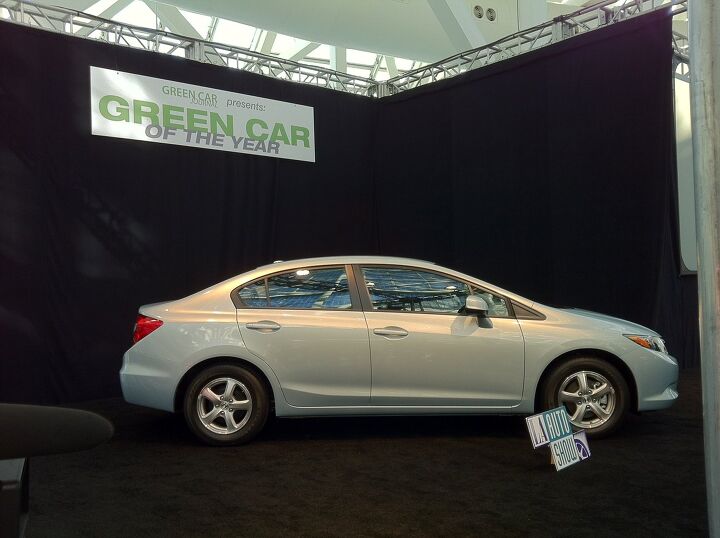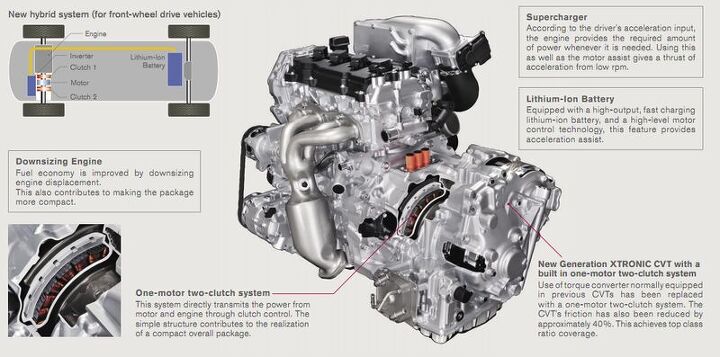#FuelEconomy
The Engine Empire Strikes Back: Honda Battles For Engine Technology Relevance
It’s been a few years since we last detected much of a pulse from Honda [Ed: in fact, Paul Niedermeyer declared Hyundai the “new Honda” in terms of engine technology leadership way back in 2009]. But just when we were wondering if all hope was lost, and that it might be time to pull the plug…signs of life. In Japan, for the Tokyo auto show, Honda has unveiled ambitious new powertrain plans [via Automotive News [sub]].
Data Of The Day: An Interactive Map Showing EV/Hybrid Sales By Location
Everyone knows TTAC hearts data, so this little NPR/Edmunds collaboration, which maps hybrid and EV sales by locality, is right up our HOV lane.
Never Mind The Growing Gap Between Oil Production And Consumption, Here's The SLS Black Series
Last Monday, we regaled you out with stories of Toyota coming to grips with the “new peak oil,” and other topics related to the growing gap ( or lack thereof?) between global production and consumption oil. This week I’m feeling a little less apocalyptic, and little bit more indulgent. And really, why not celebrate those precious hydrocarbons while they’re still cheap and plentiful? This Mercedes SLS AMG Black Series may burn ’em by the bushel, but it sure sounds good doing it. And though cars like the forthcoming 650 HP Shelby Mustang GT500 prove that performance is still alive in the 21st Century, high-revving, large-displacement, naturally-aspirated V8s like the AMG Black’s are going to be facing special challenges under future emissions standards. Which makes its gargling, chortling music all the sweeter to my ears…
Honda Launches Fit EV, But Civic GX Takes Green Car Prize
EPA Releases 2017-2025 CAFE Proposed Rule
Over the last few days we’ve been discussing the implications of the growing gap between global oil demand and production, looking at the responses of a global automaker, a radical startup and the oil industry itself. And make no mistake, it’s an uncertain future out there… unless you’re selling cars in the US. In that case, your future just arrived, planned all the way through 2025. That is, if you think this proposed rule will survive four presidential elections and one industry-government “mid-term review.” Want to familiarize yourself with this pre-planned fuel economy future? All 893 pages await your perusal, in PDF format here. Or, hit the jump for a few broad strokes.
Anwyl: Should We Be Preparing For The Next Gas Price… Collapse?
The big news around here yesterday came from Bertel’s interview with Toyota’s Chief Engineer, in which it became clear that Toyota takes the developing world’s growing demand for oil very seriously. With global demand already outstripping supply, the giant automaker’s embrace of a petroleum-constrained business model seems to make it clear that gas prices will play a significant role in the future. But markets are, by their natures, both difficult to predict, and shaped by predictions. And Edmunds CEO Jeremy Anwyl reckons that, although gas prices are high and could well go up in the short term, fears of a runaway gap between supply and demand may not materialize over the longer term. He writes:
Here’s the twist: As I said, the consensus belief (or story) on future oil prices is that they will be higher. And short term, this may be the case if and/or when the global economy recovers and/or demand grows in emerging markets.
But there is a longer-term story as well. This story suggests that peak oil may be nigh and the future holds shortages and sharply higher prices. Buying into this story, companies, acting individually, will see profit in expanding exploration, developing sophisticated new extraction technologies, etc.
The aggregate result of all these individual activities is that the future supply of oil will improve and prices will actually drop.
In fact, we have seen this paradox play out before. Through the Seventies, we were first shocked by rapid price increases and then conditioned to believe they would continue. And, of course, oil prices collapsed in the Eighties.
Wild-Ass Rumor Of The Day: Scion And Daihatsu Considering Joint Small Pickup For US?
Toyota Targets 2015 Fuel Cell Sales… At A Six-Figure Price Point
Jaguar Goes Front-Drive… Again
The last time Jaguar built an entry-level car based on front-drive architecture, it built the X-Type, a car that was nearly universally panned as “not quite a real Jaguar.” At thee time though, Ford was desperate to make a little money on its Premier Auto Group, and bringing Jaguar downmarket was the only way to do that relatively cheaply. And, all things considered, it could have been a lot worse: at least Ford was working from a good basis in the form of the Mondeo (Contour), which at the time was considered one of the better driving mass-market sedans. But if anything, the fact that the Jaguar brand was being used as Ford’s corporate pawn was a big part of why the X-Type flopped (the company’s overly-earnest insistence that the X-Type was in fact a ‘proper Jag” (see above) didn’t help either). And flop it did: sales topped out at 33k units in the US, and enjoyed only four years of rapidly-declining five-digit sales. While reviewers like Robert Farago used terms like “laughable distraction” to describe the baby Jag.
But those who don’t learn from history are destined to repeat it. Now owned by India’s Tata Motors, Jaguar is once again aiming at the entry-luxury market, and it’s planning… a front-drive sedan.
Are You Ready For: Nissan's Supercharged Hybrid?
Of all the Japanese automakers, none are as far behind on hybrid technology as Nissan. For some time there was a sense that Nissan’s (relatively) huge investment in electric vehicle production would represent a “leapfrogging” of hybrid technology, but now the firm is using the common industry response to questions about future technology: a suite of options, rather than one single technology, will meet tomorrow’s low-energy transportation needs. As a result, Nissan’s been playing catchup, as it admits in a recent press release [ PDF]
“We must have a tougher job than any other hybrid team in the industry,” says Mitsunobu Fukuda, a senior powertrain engineer at NATC. “Because our CEO, Carlos Ghosn, used to be known as skeptical about the value proposition of hybrids we had to make a really compelling case that we could deliver value to customers to get him to validate a hybrid program.
In 2004, as a stopgap measure, Nissan licensed hybrid technology from Toyota for use in certain markets.
“It was a bit of a blow to our pride, but that was the right thing to do under the circumstances,” Fukuda says.“Instead of rushing out a ‘copy-cat’ hybrid we wanted to take the time to develop our own hybrid, one that is clearly different – and better. I think we’ve managed to do that.”
What makes Nissan’s forthcoming hybrid system so different? For one thing, it uses Nissan’s “one motor, two clutch” system (currently found only on the Infiniti M Hybrid), which enables a compact design. For another, it’s supercharged.
Ask The Best And Brightest: Does Anyone Actually Get 40 MPG On The Highway?
What’s the most powerful number in automotive marketing? No, not zero, as in “zero down, zero percent interest”… the answer we’re looking for is 40, as in “40 MPG hwy.” With the compact segment heating up, 40 MPG on the highway is very nearly a price of entry… if your base model doesn’t achieve the magic number, you’d better have a special edition that does. But even as “40 MPG” becomes more and more important as an industry benchmark, it inevitably raises a perennial question: do EPA numbers mean anything in the real world? Hyping the highest possible number rather than a “combined” figure is a classic marketing move, but one that risks exposing the EPA highway number as a meaningless metric. And if nobody actually gets the rated efficiency, it’s only a matter of time before the market begins to demand more accurate reporting.
Ask The Best And Brightest: Should Chevy Get A Subcompact CUV?
According to Automotive News [sub]’s Product Editor Rick Kranz, GM execs “are debating” whether Chevrolet needs a subcompact crossover. Which is interesting, considering Buick’s next new vehicle after the Verano will likely be a subcompact crossover. But with GMC’s “Granite” moving to the Delta platform, and Buick doing a better job of differentiating itself (more on that soon, in an upcoming Verano review), that might work. Besides, the South American Chevrolet Agile (above) is based on the ancient 4200 platform which, as a “regional architecture,” is doomed to replacement with a Global Gamma-based vehicle. If you’re going to develop a global product, why not offer a version for the US market?
66 House Reps Move To Block 2017-2025 CAFE Proposal
The Detroit News reports that 66 US Representatives wrote to the House Appropriations Committee today to urge a measure blocking the EPA from regulating fuel economy in the 2017-2025 period. The letter, signed by 64 Republicans and three Democrats requests
A one-year ‘time out’ is necessary as EPA and (California) are setting national fuel economy standards without explicit authorization by Congress, under laws not designed to regulate fuel economy
According to the DetN, “the proposal would let the National Highway Traffic Safety Administration go forward with setting fuel economy requirements, but under the law it could only set new requirements through 2021.” And unlike past battles over CAFE, opposition this time around does not appear to be coming from the OEMs, but from NADA, the new car dealer lobby group. The only OEM to not sign onto proposed 2017-2025 standards is Volkswagen, which is reportedly in talks with regulators over the proposal.
Quote Of The Day: Chrysler's Fuel Economy Crunch Edition
As the automaker that’s least-prepared for upcoming increases in federal fuel economy standards, it was more than a little surprising to find that Fiat’s five year plan for Chrysler did not involve any significant plans for hybrid drivetrain development. But more recently, CEO Sergio Marchionne has said a hybrid Chrysler 300 would be offered in 2013, and the firm hooked up with the feds to work on a hydraulic hybrid drivetrain. And though new CAFE regulations offer generous credits for hybrid pickups, a policy choice that rescues Chrysler’s investment in “Two Mode” hybrid technology, more will have to be done. For, in the words of Marchionne [via Automotive News [sub]],
I have no other way of getting to 2025 numbers than by going to hybrids
But Chrysler won’t rely fully on hybrids in order to make the significant fuel economy improvements it needs. In fact, it will be relying as much on diesels and compressed natural gas (CNG) drivetrains as anything else.
Will Chevy's Cruze Diesel Be A "Game Changer"? Lutz Thinks Not
It’s a phenomenon with some precedent: import manufacturers will get nowhere with a certain bodystyle or drivetrain until one of the US domestic brands jumps on the bandwagon and popularizes it. And Jeff Breneman, executive director of the U.S. Coalition for Advanced Diesel Cars, is hoping the same dynamic plays out in the world of diesel power when Chevy brings its Cruze Diesel to the US. He tells WardsAuto
The fact that Chevy will offer a diesel Cruze in 2013 is huge. The gas-powered Cruze will get 40 mpg (5.9 L/100 km), so the diesel is expected to get 50 mpg-plus (4.7 L/100 km), and that will make it a game-changer.
Ford, Toyota or Honda haven’t got a diesel for the U.S. yet, but get ready for 2013-2014. That’s when we’re going to see a lot more diesels.
And, as the diesel booster-in-chief, it’s not surprising that Breneman would come to that conclusion. But what are folks inside GM saying about the Cruze diesel? In a recent interview with TTAC, senior advisor Bob Lutz suggested that we shouldn’t expect the Cruze diesel to conquer America or “change the game” all that much.






















Recent Comments